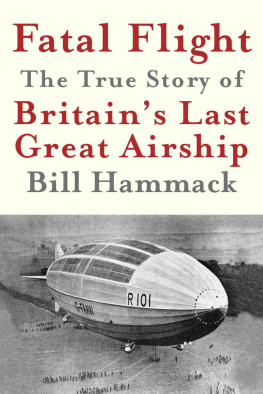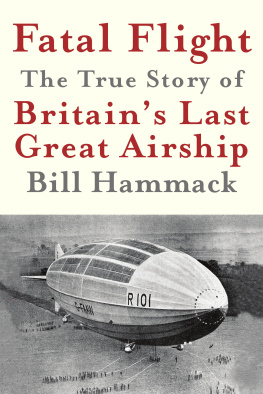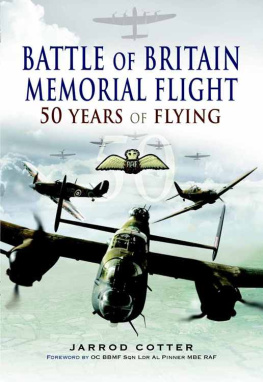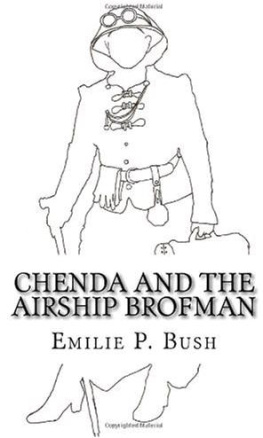Bill Hammack - Fatal Flight: The True Story of Britain’s Last Great Airship
Here you can read online Bill Hammack - Fatal Flight: The True Story of Britain’s Last Great Airship full text of the book (entire story) in english for free. Download pdf and epub, get meaning, cover and reviews about this ebook. year: 0, genre: Science. Description of the work, (preface) as well as reviews are available. Best literature library LitArk.com created for fans of good reading and offers a wide selection of genres:
Romance novel
Science fiction
Adventure
Detective
Science
History
Home and family
Prose
Art
Politics
Computer
Non-fiction
Religion
Business
Children
Humor
Choose a favorite category and find really read worthwhile books. Enjoy immersion in the world of imagination, feel the emotions of the characters or learn something new for yourself, make an fascinating discovery.
- Book:Fatal Flight: The True Story of Britain’s Last Great Airship
- Author:
- Genre:
- Year:0
- Rating:5 / 5
- Favourites:Add to favourites
- Your mark:
- 100
- 1
- 2
- 3
- 4
- 5
Fatal Flight: The True Story of Britain’s Last Great Airship: summary, description and annotation
We offer to read an annotation, description, summary or preface (depends on what the author of the book "Fatal Flight: The True Story of Britain’s Last Great Airship" wrote himself). If you haven't found the necessary information about the book — write in the comments, we will try to find it.
Bill Hammack: author's other books
Who wrote Fatal Flight: The True Story of Britain’s Last Great Airship? Find out the surname, the name of the author of the book and a list of all author's works by series.
Fatal Flight: The True Story of Britain’s Last Great Airship — read online for free the complete book (whole text) full work
Below is the text of the book, divided by pages. System saving the place of the last page read, allows you to conveniently read the book "Fatal Flight: The True Story of Britain’s Last Great Airship" online for free, without having to search again every time where you left off. Put a bookmark, and you can go to the page where you finished reading at any time.
Font size:
Interval:
Bookmark:
Fatal Flight
The True Story of Britains
Last Great Airship

Bill Hammack
Other Books by the Author
Why Engineers Need to Grow a Long Tail
Bill Hammack 2011
How Engineers Create the World
Bill Hammack 2011
Eight Amazing Engineering Stories
Bill Hammack, Patrick Ryan, & Nick Ziech 2012
Albert Michelsons Harmonic Analyzer
Bill Hammack, Steve Kranz, & Bruce Carpenter 2014
Michael Faradays The Chemical History of a Candle
Bill Hammack & Don DeCoste 2016
Copyright 2017 William S. Hammack
All rights reserved. No part of this book may be reproduced in any form by any electronic or mechanical means (including photocopying, recording, or information storage and retrieval) without permission from the publisher.
Articulate Noise Books

New York | info@articulatenoise.com
First Edition: June 2017
William S. Hammack
Fatal Flight: The True Story of Britains Last Great Airship / Bill Hammackst edition (version 1.0 )
ISBN 978-1-945441-01-1 (hbk)
ISBN 978-1-945441-02-8 (electronic)
ISBN 978-1-945441-03-5 (pbk)
. R101 (Airship).. AirshipsGreat BritainHistory.. AirshipsHistory20th century.. Aircraft accidents.. AirshipsDesign and constructionHistory. I. Title.
Never to lose an opportunity of reasoning against the head-dimming, heart-damping Principle of Judging a work by its Defect, not its Beauties. Every work must have the formerwe know it a prioribut every work has not the Latter & he therefore, who discovers them, tells you something that you could not with certainty or even with probability have anticipated .
Samuel Taylor Coleridge, Coleridges Notebooks: A Selection , ed. Seamus Perry (Oxford: Oxford University Press, 2002 ), p.
Contents
List of Illustrations
Relative Sizes of the Hindenburg , Graf Zeppelin , HMA R.101 , and USS Akron page
Inside His Majestys Airship R.101 page
R.101 s Proposed Route to India page
The Mooring Tower at the Royal Airship Works page
Route of R.101 on its First Flight over London page
The First Forty-Five Minutes of R.101 s Final Flight page
Route of R.101 s Final Flight page
Prologue
The Perennial Promise of Airships
A t four in the afternoon on Wednesday, October , 2015 , a Pennsylvania State Police officer fired a hundred shotgun blasts into the nose of a runaway blimp. The milk-white blimp , caught in a tree, sank to the ground as helium whistled from the shotgun holes. As the helium leaked, a team from the United States Army rolled up the blimps tail, which had separated when it crashed. From the tail a 6,700 -foot Kevlar tether snaked across the rugged, wooded terrain. A team cut the tether with carbon-steel-bladed scissorsKevlar is used for bulletproof vestsinto small sections, which another team loaded onto a truck.
Four hours earlier, the blimp had broken free of its mooring at the Armys Aberdeen Proving Ground near Baltimore, Maryland. Although designed to always be crewless and tethered to the ground, the -foot-long blimp had traveled miles north, crossed into neighboring Pennsylvania, and dragged its mile-long tether along the ground, terrifying local residents. Fortunately, no one was injured or killed. The whip-like cable, however, destroyed two million dollars worth of power linesa pittance compared to the now-destroyed blimps $ million cost.
The escaped blimp was part of the $ 2.7 billion Joint Land Attack Cruise Missile Defense Elevated Netted Sensor System ( JLENS ). It held aloft a radar high enough above the horizon to detect cruise missiles, drones, and other low-flying weapons. Despite its high price tag, the Pentagon rated JLENS as poor in reliability, unable to provide twenty-four-hour surveillance. It was labeled as fragile, Pentagon-speak for did not demonstrate the ability to survive in its intended operational environment. Critics called it a zombie government program: one that feeds on cash and is impossible to kill. It survived with the same justification used by proponents of lighter-than-air craft who aspired to create more than a novelty like the Goodyear blimp or the mere utilitarian and humble weather balloon. The wayward military blimps promoters promised that this newest version of a lighter-than-air craft would solve one of the most pressing problems of our time. The JLENS blimp would watch the skies and sound the alert at the first hint of an aerial attack from a rogue group or nation.
The front-page news of the runaway JLENS blimp was just that: news to almost all Americans and others around the world. Who knew we used lighter-than-air craft for anything besides covering the Super Bowl or golf tournaments? To several generations, an airship means a zeppelin, and their image is of the Hindenburg burning in the sky. Yet airships have a rich history beyond that of the iconic zeppelin.
The story of lighter-than-air craft is one of empire and national pride, of technological advances and human perseverance, of ego and bravery. While the story of winged flight is prominently part of every history textbook, that of lighter-than-air craft, though more glorious and tragic, is largely untold in the modern day. In their heydaybetween the First and Second World Wars and before transcontinental airplane flightairships the size of the Titanic were the preferred method of travel between continents.
The allure of lighter-than-air craft to solve pressing problems can be traced back for decades. In 1997 , six years after the first web page was posted, a company called Sky Station solicited $ 4.2 billion to built antenna-equipped blimps to deliver Internet service. In May 1985 , the British Antarctic Survey revealed a hole in the ozone layer over the South Pole, and a few years later a professor suggested sending blimps that dangled electrical wires to zap ozone-eating chemicals. In the 1970 s, the Aereon Corporation proposed a hybrid lighter-than-air craft that would take off like a jet, then float like a blimp. This aerial workhorse would inexpensively usher all nations into the twentieth centuryno need for costly infrastructure such as roads, railroads, tunnels, bridges, airports, warehouses, or harbors. In the 1950 s and s, when nuclear fuels promised unlimited energy, a Boston University professor proposed a nuclear-powered version of the airship.
The airshipthe largest version of any lighter-than-air craftcarried the heaviest payload and traveled at the highest speed of any lighter-than-air craft. This superior performance occurred because an airships construction differed dramatically from that of a free balloon or a blimp. The latter two are both pressure vessels: their shape is maintained by the pressure of the lifting gas. In contrast, an airships shape is formed by a metal framework. The metal skeleton houses gas bags that lift the ship, and a cloth cover stretched across the framework protects the gas bags from weather. This structure enables an airship to travel faster than a blimp: the force of the wind generated deforms the nose of a blimp, while the framework of an airship keeps its nose rigid when cutting through the sky.
The greatest advantage of the airships more complex structure is the larger payload it can carry. For example, the proposed nuclear-powered airship was to be feet long and would haul passengers and ninety tons of cargo. For freight , explained the ships designer, like motor cars and other bulky manufactured equipment, the airship would offer the lowest per ton-mile costs between factory and destination. These characteristics of an airship appealed not only to commercial interests, but also to governments with imperial ambitions.
Next pageFont size:
Interval:
Bookmark:
Similar books «Fatal Flight: The True Story of Britain’s Last Great Airship»
Look at similar books to Fatal Flight: The True Story of Britain’s Last Great Airship. We have selected literature similar in name and meaning in the hope of providing readers with more options to find new, interesting, not yet read works.
Discussion, reviews of the book Fatal Flight: The True Story of Britain’s Last Great Airship and just readers' own opinions. Leave your comments, write what you think about the work, its meaning or the main characters. Specify what exactly you liked and what you didn't like, and why you think so.












